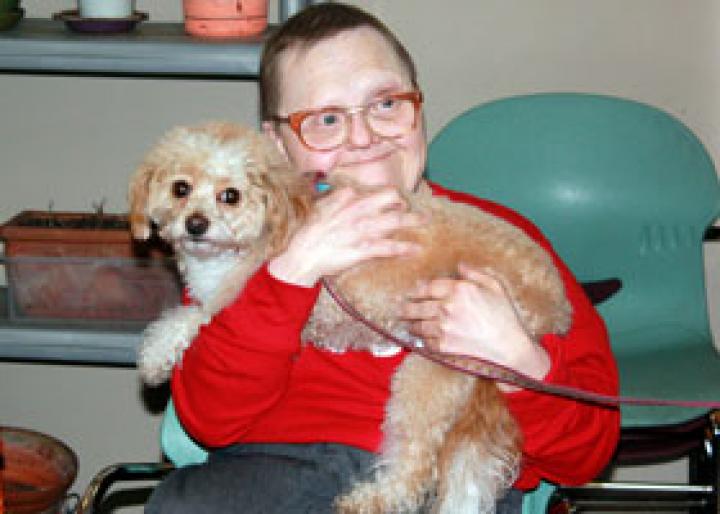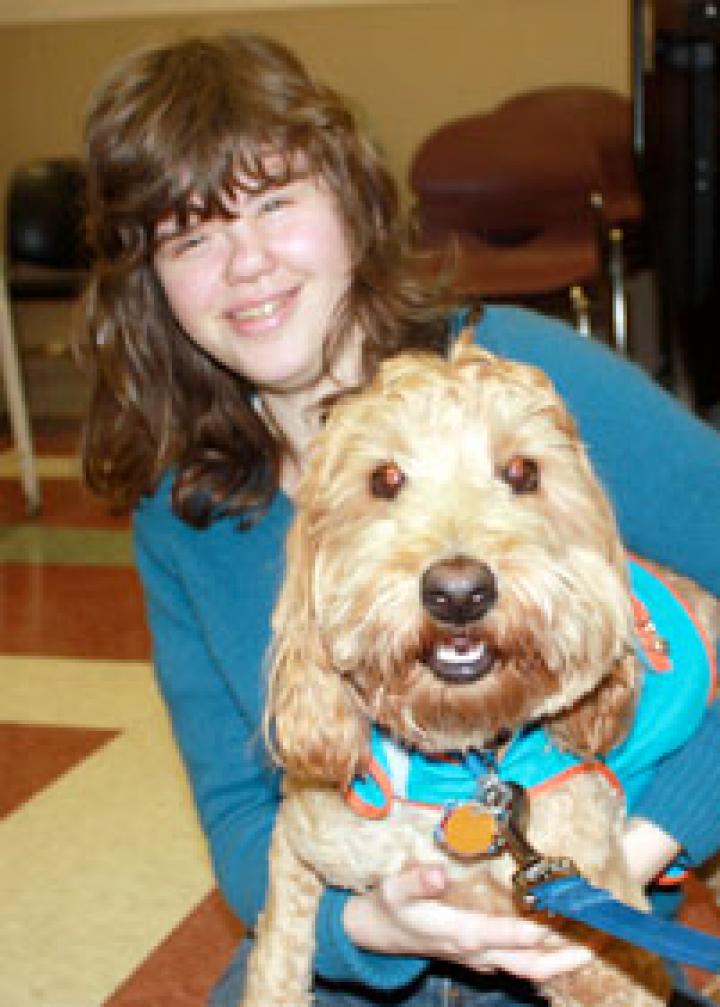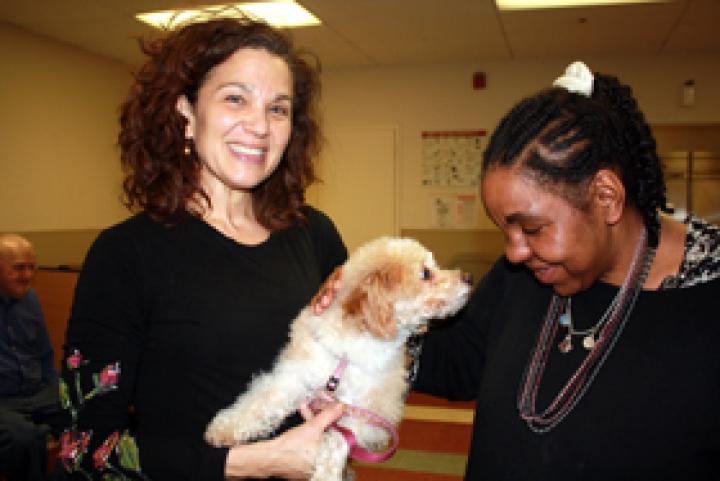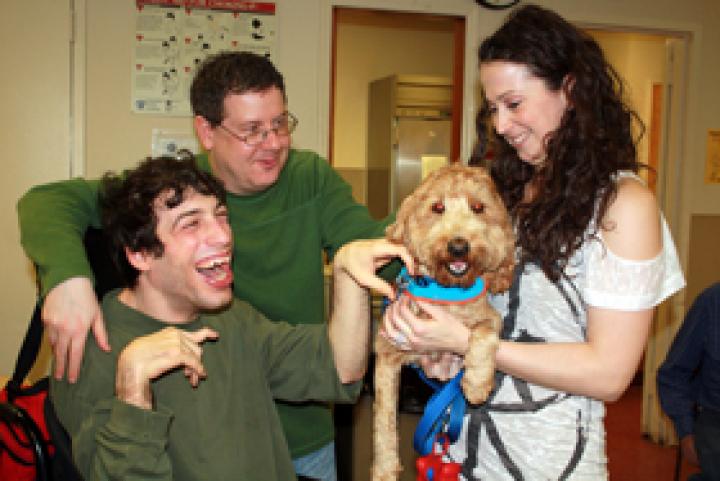Share
YAI’s Manhattan Day Services has gone to the dogs. Therapy dogs, that is!

“I’m so happy when the dogs are here,” said Liz, a Day Services participant who never misses a visit with her furry friends. Liz is particularly fond of Keeney, a 3 year old Terrier mix who enjoys sitting in Liz’s lap while she scratches his ears.
Keeney and his owner, Margaret Wailes, are one of several pet partner teams from The Good Dog Foundation in Brooklyn who visit the YAI program every two weeks. These visits offer more than 75 participants opportunities to play and interact with the tail-wagging dogs.

“I wanted to get involved as a volunteer and I love that this is something that Keeney and I can do together,” said Margaret, a real estate agent in New York City. The duo was certified by The Good Dog Foundation in 2010 and began visiting YAI immediately. “The best part is being here – the welcome that participants always give us is really special. Everyone is smiling and eager to take turns petting and playing with Keeney and the other therapy dogs.”
“Dogs offer intimacy and familial connection,” said David Jay Smith, Senior Clinician at the day program. On behalf of YAI, David coordinated efforts with The Good Dog Foundation in 2009, and has since watched the program flourish. “There are definite therapeutic benefits,” he said. “Participants meet dogs in a safe environment and this prepares them to be comfortable around dogs while out in the community. We’ve decreased phobias and improved confidence.”
Benefits of Animal-Assisted Therapy
Research suggests that Animal-Assisted Therapy can play an important role in a person’s physical, social, educational and emotional well-being. It can be an effective addition to traditional physical or occupational therapy models.

Animal-Assisted Therapy programs are growing in popularity across the country. In Salt Lake City, UT, Intermountain Therapy Animals – which specializes in providing animal-assisted therapy to individuals who have both physical and developmental disabilities – has found that interactions with the dogs lowers participant blood pressure and increases social skills. In Greensboro, NC, pet partner volunteers make regular visits to the Morehead Nursing Center, where staff document how aging clients show fewer signs of depression and more openness in discussing feelings when a dog is in the room. And in Rockville Centre, NY, Wilson Elementary School has partnered with Bide-A-Wee to create a “Reading to Dogs” program through which students who are shy or have difficulty with literary skills can read to a dog. In the presence of the non-judgmental animals, teachers report, children show improvements in motor skills, emotional-control, peer relations and self-confidence.
Temple Grandin, Ph.D., a professor of animal science who is herself diagnosed with autism, has explored similarities between the thinking and learning patterns of animals and individuals with autism. Her work of more than 30 years is chronicled in the best-selling book, “Animals in Translation,” and several others. Her research details how understanding animal behavior can shed new light on autism, and how interactions with animals can enhance traditional therapy. “Both my thinking animal’s thinking are sensory based instead of being based on verbal language. A dog will store memories in its brain in the form of images, sounds, tastes, touch feelings or smells of specific things that it has experienced… a person [with autism] who uses sensory perception instead of verbal thoughts to understand the world is more likely to relate well to an animal that may perceive the world in similar ways.”
Building Confidence, Community and Social Skills
Staff at Manhattan Day Services use the visits with the dogs as an opportunity to teach participants about the proper ways to interact with dogs when out in the community, including not petting a dog without the owner’s permission, touching the dog gently, not pulling on tails and not running away from a dog, into the street, if you are scared.
“Some of the participants that I work with are afraid of dogs,” explained David. “But the animal-assisted therapy visits are a wonderful way to desensitize in a supervised environment so that no one has a fearful reaction when out in the community near a busy road.”

According to staff, the regularly scheduled visits also help reinforce lessons on time management.
“All of the participants know that the dogs visit on Thursday after lunch, and this consistency helps many establish a schedule and understand time,” said Carlos Pina, Direct Service Professional II, who has worked for YAI for 11 years.
Carlos described Michael, who has Alzheimer’s and dementia, as someone who prefers tasks he can complete on his own. “But on Thursday afternoons, that all changes,” shared Carlos. “He is more engaged, positive and social. And the elevation in his mood will last the entire rest of the day – it’s wonderful.”
Another participant, Blanca, gets so excited for each visit with the dogs that she bursts into song. Blanca welcomes the dogs and their owners into the building to the tune of “Sandy,” an ode to the well-known canine from Annie.
A Special Connection
According to David, one of the most powerful transformations has been Teri, who is often non-verbal and generally sits with her head and eyes pointed down at the floor. “One week I decided to bring a small dog over to sit in her lap,” said David. “And the results weren’t immediate – but over time something just began to change. Teri wraps her arms around the dogs and tells them, ‘I love you so much.’” David and other staff members, who rarely hear her speak, could not believe the transformation that they were all witnessing. Added David, “Teri still does not often speak to staff, but the dogs have touched her on a neurological level and connected with her in a way that humans cannot. I can’t explain the how or the why, but it is absolutely profound.”
The success of the program would not be possible without the other half of the doggy duo – the owner! The pet partners have developed friendships with participants which builds social skills. Owners also help to reinforce the skills on how to pet, groom, walk and feed biscuits to the dogs.
“I think the program is so successful because of the instant bond that humans and animals can form,” added Margaret. “There is something powerful about the unconditional love that an animal offers.”
David agrees. “I can’t express enough how wonderful an environment it is for both participants and staff when the dogs are around.” As he looks affectionately at a photo on his desk of a participant happily petting a dog, David adds: “In these tough economic times, this is a free service that is a win-win for everyone involved. Dogs don’t see differences or disabilities - they just see love. And they give that love unconditionally.”
Check out more photos from the dogs' visit!
